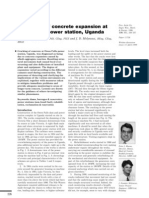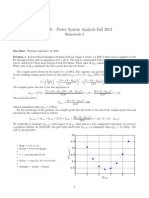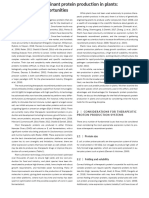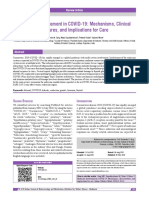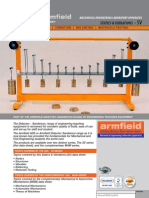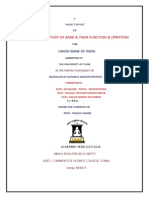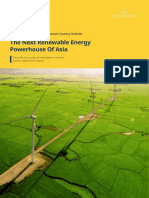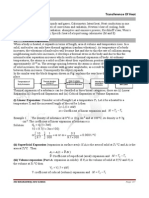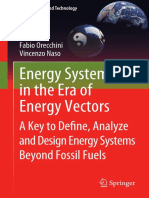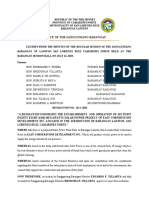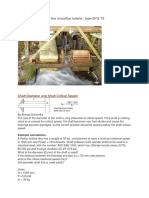Microbio Fuel Cell 2
Microbio Fuel Cell 2
Uploaded by
coding727treeCopyright:
Available Formats
Microbio Fuel Cell 2
Microbio Fuel Cell 2
Uploaded by
coding727treeOriginal Description:
Copyright
Available Formats
Share this document
Did you find this document useful?
Is this content inappropriate?
Copyright:
Available Formats
Microbio Fuel Cell 2
Microbio Fuel Cell 2
Uploaded by
coding727treeCopyright:
Available Formats
Microbio Fuel Cell
Introduction:
A microbial fuel cell (MFC) is a device that converts chemical energy to electrical energy by
the action of microorganisms. These electrochemical cells areconstructedusing either a
bioanode and/or a biocathode. Most MFCs contain a membrane to separate the compartments of
the anode (where oxidation takes place) and the cathode (where reduction takes place). The
electrons produced during oxidation are transferred directly to an electrode or to a redoxmediator
species.
How do MFCs work?
In MFC ,the electrons undergo a reduction
reaction.This is a chemicalprocess in which electrons
are absorbed. Astheelectrons movefromanode to cathode, they create an electric current. This can
dowork, such as power a light bulb.
Importance of the study?
Microbial fuel cells can harvestelectricity from electrode-reducing organisms that
donateelectrons to the anode. While the microorganism oxidizes organic compounds or
substrates into carbon dioxide, the electrons are transferred to the anode.
Using microbial fuel cells may help reduce environmental contaminants such as
wastewater ,reduce atmospheric carbon dioxide by using it to rebuilds fuels, and may
potentially provide a renewable energy source .
Beside it , By using microbial fuel cell we can create electricity through the use of
microorganisms.Organisms that transfer electrons to the anode are called electrode-
reducing organisms.
Review :
Microbial fuel cell as new technology for bioelectricity
generation
Recently, great attentions have been paid to microbial fuel cells due to their mild
operating conditions and using variety of biodegradable substrates as fuel.
Microorganisms actively catabolize substrate, and bioelectricities are generated.
MFCs could be utilized as power generator in small devices such as biosensor.
Besides the advantages of this technology, it still faces practical barriers such as low
power and current density.
In the present article different parts of MFC
such as anode, cathode and membrane have been
reviewed and to overcome the practical
challenges in this field some practical options
have been suggested. Also, this research review
demonstrates the improvement of MFCs with summarization of their advantageous
and possible applications in future application.
The development of low-cost materials and more efficient systems, with high higher
power outputs and durability, are crucial towards the application of MFCs in
industrial/large scale. This work is a helpful tool for discovering new operation and
design regimes.
Performance of stacked microbial fuel cells with barley–
shochu waste
The treatment of barley–shochu waste combined with electricity generation was
examined using stacked microbial fuel cells . The maximum chemical oxygen
demand (CODCr) removal efficiency and maximum power density were achieved at
36.7 ± 1.1% and 4.3 ± 0.2 W m⁻³ (15.7 ± 0.9 mW m−2). The acetic acid concentration
in effluent increased, whereas the citric acid, ethanol and sugar concentrations
decreased during the operation. Microbial community analysis of the anode cell
suspension and raw barley–shochu waste revealed
that Clostridiaceae, Acetobacteraceae, and Enterobacteriaceae became
predominant after the operation, implying that microorganisms belonging to these
families might be involved in organic waste decomposition and electricity generation
in the SMFCs.
Future trends of MFC
Though many types of research have proved MFC performance, still a few
bottlenecks as listed below are there. Materials should have high durability, be less
expensive, have more power output, reduced ohmic resistance, good electron
acceptors, etc., Future research is mainly focused on a reasonable design of reactors
with less internal resistance, using nanoparticles for enhancing electron transfer,
using hereditarily designed micro-organisms and pretreated inoculum, diminishing
the start-up.
You might also like
- UserManual R45Document52 pagesUserManual R45miguel angel gracia ruizNo ratings yet
- Effects of Perceived Brand Localness and Perceived Brand Globalness On Consumer Behavioral Intentions in Emerging Markets - Management DecisionDocument21 pagesEffects of Perceived Brand Localness and Perceived Brand Globalness On Consumer Behavioral Intentions in Emerging Markets - Management DecisionSINDY ZAVALANo ratings yet
- Owen Falls MovementsDocument12 pagesOwen Falls Movementssemuwemba100% (3)
- Homework SolutionsDocument4 pagesHomework Solutionslookitsnichole0% (1)
- Masdar City-Case StudiesDocument19 pagesMasdar City-Case Studiestabbybatra1331No ratings yet
- Energuide Label InfographicDocument1 pageEnerguide Label InfographiclindaNo ratings yet
- Ajiobusiness Terms and ConditionsDocument4 pagesAjiobusiness Terms and ConditionsAamir KhanNo ratings yet
- PlantsDocument9 pagesPlantsKipkorir David LangatNo ratings yet
- Information Memorandum - The Dunes Cotton TreeDocument17 pagesInformation Memorandum - The Dunes Cotton TreekatrinajamesdesignNo ratings yet
- Statistics Interview QuestionsDocument5 pagesStatistics Interview QuestionsAkash MaityNo ratings yet
- Business Improvement DistrictsDocument27 pagesBusiness Improvement DistrictstaliagcNo ratings yet
- 2020 Afida Annual ReportDocument236 pages2020 Afida Annual ReportJeff WyattNo ratings yet
- Insertion & Tuition Fee LSPR Undergraduate (S1) E-Learning Batch 6B.1Document4 pagesInsertion & Tuition Fee LSPR Undergraduate (S1) E-Learning Batch 6B.1Audy Nesya DyaNo ratings yet
- Local Table - May 2023Document6 pagesLocal Table - May 2023inforumdocsNo ratings yet
- Request For Proposals: Provision of Technical Services FOR Aviation Fuel Handling and Into-Plane OperationsDocument61 pagesRequest For Proposals: Provision of Technical Services FOR Aviation Fuel Handling and Into-Plane Operationsa769No ratings yet
- Sdjbkssjovsnf HSFJBFDJKDocument5 pagesSdjbkssjovsnf HSFJBFDJKMeita RamaputriNo ratings yet
- 01-06 Interface Management Commands PDFDocument68 pages01-06 Interface Management Commands PDFalan smithNo ratings yet
- Playsar ReportDocument102 pagesPlaysar ReportMohd HashimNo ratings yet
- Eatro BolshóiDocument22 pagesEatro Bolshóijorge rasmussenNo ratings yet
- India Independence Day 77th - Google SearchDocument1 pageIndia Independence Day 77th - Google Searchyw7c4mtkzwNo ratings yet
- Unit 2 - Anh 11Document2 pagesUnit 2 - Anh 11Anh TranNo ratings yet
- Filed: Patrick FisherDocument12 pagesFiled: Patrick FisherScribd Government DocsNo ratings yet
- Bid Document Goods SQ Nea-Dddc-079!80!02 (SQ) - ReDocument44 pagesBid Document Goods SQ Nea-Dddc-079!80!02 (SQ) - ReShivshankar mahatoNo ratings yet
- Unit 4 - Enquiry Letter Samples + Final ExerciseDocument9 pagesUnit 4 - Enquiry Letter Samples + Final ExerciseTang TeacherNo ratings yet
- Northfield 350th Year-End Mailer To Residents and Businesses, 12.15.22Document4 pagesNorthfield 350th Year-End Mailer To Residents and Businesses, 12.15.22Shelby AshlineNo ratings yet
- Request Form For Changes in Demographics PDFDocument2 pagesRequest Form For Changes in Demographics PDFAmit Gothi0% (1)
- How To Read The Letters (Bible Project)Document56 pagesHow To Read The Letters (Bible Project)Toga Reynold HutaurukNo ratings yet
- Big Data Architectures: A Detailed and Application Oriented ReviewDocument11 pagesBig Data Architectures: A Detailed and Application Oriented ReviewSneha GuptaNo ratings yet
- Date: 11 March 2021 MR Rahul Sharma Rze2 Mahavi Enclave New Delhi New Delhi 110045 Delhi Policy No.: 16811926 Mobile No.: Xxxxxx3693Document6 pagesDate: 11 March 2021 MR Rahul Sharma Rze2 Mahavi Enclave New Delhi New Delhi 110045 Delhi Policy No.: 16811926 Mobile No.: Xxxxxx3693Rahul SharmaNo ratings yet
- CCNA 200-120 Questions: INTRODUCTIONDocument117 pagesCCNA 200-120 Questions: INTRODUCTIONPaul MayombweNo ratings yet
- The Gazette of Pakistan EXTRAORDINARY PUDocument91 pagesThe Gazette of Pakistan EXTRAORDINARY PUAli KalantariNo ratings yet
- Maharashtra State Road Transport CorporationDocument2 pagesMaharashtra State Road Transport CorporationPRADEEP GAIKWADNo ratings yet
- Atmnibhar PPT Pune Final 1Document42 pagesAtmnibhar PPT Pune Final 1Sandipan ThombareNo ratings yet
- VX Series User ManualDocument121 pagesVX Series User Manualthangpv94No ratings yet
- Ip Lab ManualDocument52 pagesIp Lab Manualanuj1166No ratings yet
- Price List As of 07.15.22 - CombinedDocument19 pagesPrice List As of 07.15.22 - CombinedPaniqui Car TradeNo ratings yet
- 74 LVC 4245 ADocument17 pages74 LVC 4245 AAMNo ratings yet
- Model Questions - Legal & Regulatory Aspects of BankingDocument8 pagesModel Questions - Legal & Regulatory Aspects of BankingKhanal PremNo ratings yet
- Pavithra DDocument53 pagesPavithra Dshubham singhNo ratings yet
- 180 CRF 4478 Job+DescriptionDocument16 pages180 CRF 4478 Job+DescriptionAlexa SienesNo ratings yet
- Garg Et Al - Endocrine Involvement in COVID 19 Mechanisms, Clinical Features, and Implications For CareDocument6 pagesGarg Et Al - Endocrine Involvement in COVID 19 Mechanisms, Clinical Features, and Implications For CareerixNo ratings yet
- MA2030 Amplificador ManualDocument2 pagesMA2030 Amplificador ManualWallace FernandesNo ratings yet
- ODF Vs OOXML LatestDocument91 pagesODF Vs OOXML Latestanon-442508No ratings yet
- Integrating ADCDocument4 pagesIntegrating ADCAlessio NittoliNo ratings yet
- VoyagerMulti 5.6.1.26 - Release BulletinDocument16 pagesVoyagerMulti 5.6.1.26 - Release Bulletincristhian alfonsoNo ratings yet
- Karev-1986-American Journal of Physical AnthropologyDocument14 pagesKarev-1986-American Journal of Physical AnthropologyEmrah ÇAMNo ratings yet
- Ground Water PolicyDocument65 pagesGround Water PolicyTej Binod PandeyNo ratings yet
- 13 PDFDocument13 pages13 PDFsriyajambukarNo ratings yet
- PS/Consolidated Premium Statement /ver 2.1/jan 2021: A Reliance Capital CompanyDocument1 pagePS/Consolidated Premium Statement /ver 2.1/jan 2021: A Reliance Capital CompanyJhansi RokatiNo ratings yet
- Armfield DidacticDocument16 pagesArmfield DidacticelenamoisoniNo ratings yet
- Schneider NS1000N MCCBDocument3 pagesSchneider NS1000N MCCBzia6182No ratings yet
- TAKE 23012023154403 Reg47 Intimation Newspaper 23012022 TSLDocument3 pagesTAKE 23012023154403 Reg47 Intimation Newspaper 23012022 TSLSushant KoulNo ratings yet
- Contempo Arts w1Document8 pagesContempo Arts w1Eric Cris TorresNo ratings yet
- Niven, Larry - Gift From Earth, ADocument117 pagesNiven, Larry - Gift From Earth, Aemh.emhNo ratings yet
- Conformational Specificity of The c4f6 Sod1 Antibody Low Frequency of Reactivity in Sporadic Als CasesDocument13 pagesConformational Specificity of The c4f6 Sod1 Antibody Low Frequency of Reactivity in Sporadic Als CasesNo DistractionNo ratings yet
- Union Bank Project KTPDocument77 pagesUnion Bank Project KTPGanesh KardileNo ratings yet
- R V ChandranDocument3 pagesR V Chandran3701Dhanush NadarNo ratings yet
- Stroberi 3 (Luvi 2018)Document6 pagesStroberi 3 (Luvi 2018)Muhammad Ammar HassanNo ratings yet
- ETA E Report - Sept 2021 2Document21 pagesETA E Report - Sept 2021 2Nazmus Salehin RubelNo ratings yet
- Experimental Study To Measure The Transmission Loss of Double Panel Natural FibersDocument5 pagesExperimental Study To Measure The Transmission Loss of Double Panel Natural Fibersghanshyam moholeNo ratings yet
- Open Bionics LTD Ob Valuation Exit Opportunities 2022Document4 pagesOpen Bionics LTD Ob Valuation Exit Opportunities 2022Dragan SaldzievNo ratings yet
- Design and Analysis of High Efficiency DC - DC Boost Converter For EV Charging ApplicationsDocument9 pagesDesign and Analysis of High Efficiency DC - DC Boost Converter For EV Charging ApplicationsIJRASETPublicationsNo ratings yet
- Amc She Env Pro 0007 Hazardous Materials ManagementDocument29 pagesAmc She Env Pro 0007 Hazardous Materials ManagementgrantNo ratings yet
- Group 14 Word DocumentDocument8 pagesGroup 14 Word Documenttemitayo paulNo ratings yet
- AdientDocument6 pagesAdientcoding727treeNo ratings yet
- Asdsadsadsadasdsadsadsadqwfew 09 Jre 89 VNCT 8 W 7 Mti 6 CGX 7 Yweix 7 WbnixmDocument94 pagesAsdsadsadsadasdsadsadsadqwfew 09 Jre 89 VNCT 8 W 7 Mti 6 CGX 7 Yweix 7 Wbnixmcoding727treeNo ratings yet
- DSA SheetDocument24 pagesDSA Sheetcoding727treeNo ratings yet
- SsadadsdsdaDocument10 pagesSsadadsdsdacoding727treeNo ratings yet
- Most Important: 53 SQL InterviewDocument16 pagesMost Important: 53 SQL Interviewcoding727treeNo ratings yet
- Surface Chemistry-Pages-11Document1 pageSurface Chemistry-Pages-11coding727treeNo ratings yet
- Schedule PlanDocument7 pagesSchedule Plancoding727treeNo ratings yet
- CN SlotDocument8 pagesCN Slotcoding727treeNo ratings yet
- Surface Chemistry-Pages-5Document1 pageSurface Chemistry-Pages-5coding727treeNo ratings yet
- Chemical EquilibriumDocument11 pagesChemical Equilibriumcoding727treeNo ratings yet
- Surface Chemistry-Pages-4Document1 pageSurface Chemistry-Pages-4coding727treeNo ratings yet
- Physical Chemist of SolutionsDocument16 pagesPhysical Chemist of Solutionscoding727treeNo ratings yet
- Project DatabaseDocument4 pagesProject Databasecoding727treeNo ratings yet
- 6th All SyllubusDocument31 pages6th All Syllubuscoding727treeNo ratings yet
- Aliphatic CompoundsDocument11 pagesAliphatic Compoundscoding727treeNo ratings yet
- Odd 8Document5 pagesOdd 8coding727treeNo ratings yet
- Even3 (2021)Document3 pagesEven3 (2021)coding727treeNo ratings yet
- Even6 (2021)Document2 pagesEven6 (2021)coding727treeNo ratings yet
- Even10 (2021)Document9 pagesEven10 (2021)coding727treeNo ratings yet
- Fuel CellDocument8 pagesFuel Cellcoding727treeNo ratings yet
- New Microsoft Office Word DocumentsaddsadadsasDocument7 pagesNew Microsoft Office Word Documentsaddsadadsascoding727treeNo ratings yet
- ReviewDocument4 pagesReviewcoding727treeNo ratings yet
- ProjectDocument9 pagesProjectcoding727treeNo ratings yet
- Nov - 14, Trans Line 220kv StatusDocument121 pagesNov - 14, Trans Line 220kv Statusnishith001No ratings yet
- MechanicalDocument2 pagesMechanicaljvc_84No ratings yet
- DPL Training Project PDFDocument18 pagesDPL Training Project PDFBhupesh yadavNo ratings yet
- The Use of Renewable Feedstock in UV-curable Materials - A New Age For Polymers and Green ChemistryDocument31 pagesThe Use of Renewable Feedstock in UV-curable Materials - A New Age For Polymers and Green ChemistryAurora Draghia100% (1)
- Thermal KineticsDocument37 pagesThermal KineticsgowthamiNo ratings yet
- Pedrollo Submersible Vortex Pump - VXDocument2 pagesPedrollo Submersible Vortex Pump - VXGeorge CobraNo ratings yet
- APES Unit 6 Notes FramesDocument14 pagesAPES Unit 6 Notes FramesKIM JEEHEENo ratings yet
- CPWD Guidelines FOR Sustainable Habitat: Central Public Works Department March, 2014Document41 pagesCPWD Guidelines FOR Sustainable Habitat: Central Public Works Department March, 2014Purvita ShahNo ratings yet
- Lehra Brochure 2014Document20 pagesLehra Brochure 2014Stef StenfordNo ratings yet
- IC Engines IntroductionDocument39 pagesIC Engines IntroductionalagurmNo ratings yet
- Solid State Motor ControDocument22 pagesSolid State Motor ControJesse Jones SeraspeNo ratings yet
- Energy VectorsDocument366 pagesEnergy VectorsHossam Eldin TalaatNo ratings yet
- COMPONENTE Rotary Drilling RigDocument65 pagesCOMPONENTE Rotary Drilling RigsteauafaranumeNo ratings yet
- Important Instructions To Examiners:: (Autonomous)Document16 pagesImportant Instructions To Examiners:: (Autonomous)ironman08102006No ratings yet
- Res. No.26-2023 SOLAR POWER FARMDocument3 pagesRes. No.26-2023 SOLAR POWER FARMRosemarie España PaleroNo ratings yet
- 3 Hours / 70 Marks: Seat NoDocument3 pages3 Hours / 70 Marks: Seat NomeghrajkadamNo ratings yet
- 0511 s17 QP 23Document16 pages0511 s17 QP 23pritiNo ratings yet
- Disano - Catalogo LED (2013)Document8 pagesDisano - Catalogo LED (2013)francescopetracconeNo ratings yet
- DIVYASRI257 ReportDocument20 pagesDIVYASRI257 ReportBhargavNo ratings yet
- Ms Komal Kareen NCET InvitationDocument1 pageMs Komal Kareen NCET InvitationUbaid RehmanNo ratings yet
- Revolutionary New Design!: Vertical Axis Involute Spiral Wind TurbineDocument20 pagesRevolutionary New Design!: Vertical Axis Involute Spiral Wind TurbineSatish Rathod100% (1)
- The Application of "Green Economy" Policy of Switzerland and Sweden To The Karabakh Region of Azerbaijan: Review and AppraisalDocument19 pagesThe Application of "Green Economy" Policy of Switzerland and Sweden To The Karabakh Region of Azerbaijan: Review and AppraisalNonik DeppNo ratings yet
- An Example Design of The Crossflow TurbineDocument58 pagesAn Example Design of The Crossflow TurbineBryan NanaNo ratings yet
- Review For Electricity Unit Test: Grade 9 Science NameDocument2 pagesReview For Electricity Unit Test: Grade 9 Science NameJohnson LiNo ratings yet
- Ipc2010 31293Document10 pagesIpc2010 31293Sriven ReddyNo ratings yet
- APFC Class Notes BasicsDocument37 pagesAPFC Class Notes BasicsRamesh Ananthanarayanan100% (1)


